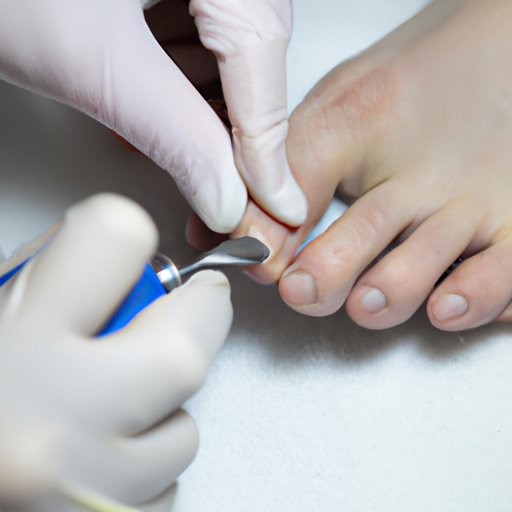I. Introduction
Ingrown toenails happen when your toenail grows into the skin around it, causing pain, inflammation, and sometimes infection. They can happen to anyone, but they’re more common in people who wear tight shoes or have naturally curved nails. In this article, we’ll explore how to get rid of ingrown toenails at home and when to seek professional help.
II. Soaking the Toe
Soaking your toe in warm, soapy water can help reduce pain and infection. Here’s how to do it:
- Fill a bowl with warm water and a few drops of mild soap
- Place your foot in the water and soak for 15-20 minutes
- Repeat 2-3 times a day until the pain subsides
III. Proper Toe Nail Cutting Technique
One of the main causes of ingrown toenails is improper nail trimming. Here’s how to cut your toenails properly:
- Use nail clippers to trim your nails straight across
- Don’t cut your nails too short, as this can expose the sensitive skin underneath
- Avoid overly rounded cuts that can cause the nail to grow into the skin
IV. Using Cotton or Dental Floss
If you have an infection or the skin around your toenail is swollen, you can use cotton or dental floss to promote regrowth over the skin. Here’s how to do it:
- Soak a small piece of cotton or dental floss in antiseptic solution
- Gently lift the edge of the nail and place the cotton/floss underneath
- Replace the cotton/floss daily until the nail grows out
V. Medications
If your ingrown toenail is causing significant pain and inflammation, you can use medications to help alleviate the symptoms. Here are some options:
- Anti-inflammatory medication such as ibuprofen can help reduce pain and swelling
- Topical antibiotic ointments can help prevent infection
- Always follow the instructions on the medication and talk to your doctor if you have any questions or concerns
VI. Laser and Surgical Treatment
If your ingrown toenail is severe, recurrent, or causing an infection, you may need professional treatment. Laser treatment involves removing the ingrown portion of the nail, while surgery involves removing the entire nail and sometimes part of the nail bed. Both procedures are usually done under local anesthesia and are generally safe and effective.
VII. Conclusion
Ingrown toenails can be painful and inconvenient, but with the right care and attention, you can get rid of them at home. Remember to soak your toe, cut your nails properly, use cotton/floss if necessary, and consider medications or professional treatment if needed. If you experience any persistent pain or infection, seek medical help promptly.
